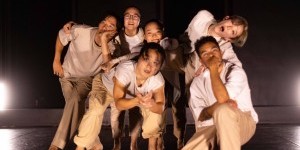AUDIENCE REVIEW: Infinita Compañía in "Once I Saw A Hummingbird"

Company:
Infinita Compañía, Choreographer Raúl Támez
Performance Date:
December 9, 2022
Freeform Review:
ONCE I SAW A HUMMINGBIRD
Choreographer: Raúl Támez
Dancers: Paulina del Carmen Fernández and José Ortiz of Infinita Compañía
Venue: Bruno Walter Auditorium of the New York Public Library for the Performing Arts, 111 Amsterdam Avenue, New York NY
Date: Friday, December 9, 2022 @ 6:45 PM
The occasion for this performance was the 200th anniversary of diplomatic relations between Mexico and the United States. The event was organized by Fulbright-COMEXUS Becas (Scholarships) Fulbright-Garcia Robles. Since its founding in 1990, the United States-Mexico Commission for Educational and Cultural Exchange (COMEXUS) has awarded grants to over 5000 U.S. and Mexican citizens to study, research, teach, and develop professionally at prestigious institutions in both countries.
I do not know why contemporary dance was chosen by COMEXUS to be featured as the focal point of this celebration. There is no information in the program about a Fulbright grant for Támez on his Facebook page. But how good and visionary were the organizers of the event to challenge the audience with an event so far from mariachi or the Day of the Dead or what many might have seen as touristic or otherwise predictable manifestations of Mexican culture.
Támez is nominated for a Bessie Award for his choreography “Migrant Mother” premiered by the José Limón Dance Company at the Joyce Theater in spring 2022. That ceremony takes place in New York City December 16. It made sense for the two recognitions to take place in the same week.
Támez chose to show the work “Once I Saw A Hummingbird” on the narrow stage of the Bruno Walter Auditorium of the New York Public Library for the Performing Arts, a stage perhaps 12 feet deep by 40 feet wide. I don’t know what the work might have looked like on a typical dance stage 40 feet wide by 32 deep. In this space, it had to have been a challenge - and Támez told me it was - to adapt the work to this space. Paulina del Carmen Fernández and José Ortiz met the challenge, stalking towards and away from each other, he from stage left to stage right, she from stage right to stage left, then reversing. To present choreographer and dancers with such a challenge, and to have them surmount it in unfoldings which never became facile, predictable, or boring, is a hard challenge to rise above.
The word “stalking” expresses the bravery, fearlessness, and animalian power of the two dancers. They sometimes pause as they pass each other, as cats, dogs, and other animals will do when assessing the terrain or the danger or the identity of the one approaching: Friend or foe? Sometimes one slowed down, sometimes both slowed down. Sometimes one crossed the space, voluptuously enjoying the commandeering of the space, as though they had consciously or unconsciously beaten down the opposition. Rarely, they dance together, del Carmen Fernández clambering over Ortiz’ shoulder in one instance.
Ortiz’ yard of silky jet black hair, which sometimes completely obscures his face, is almost a third character. It throws me distractedly for a moment into the world of Cousin Itt of Charles Addams’ macabre series The Addams Family. But life IS macabre. Dance IS macabre. And as T.S. Eliot once said, the poet writes only half the poem, the reader writes the other half. Támez may not know of Charles Addams or Cousin Itt, but the hairy semi-human half-obscured, unknowable, perhaps threatening, figure is archetypal. They are in turquoise-colored long cotton robes with puffed sleeves, stoles draped around their shoulders and down the front, decorated in multi-colored chevrons, indicating some hybrid between a hummingbird’s iridescence and a monk’s or nun’s austerity and simplicity.
One constant of the piece is that we must ask why it is called Once I Saw a Hummingbird. Hummingbirds are known for being tiny and iridescent and for, despite their size, migrating vast distances across the hemispheres as seasons change. It is well known that they are among the most aggressive, territory patrolling and controlling animals on earth. Once I was on my hands and knees planting a small flowering hosta in my garden. I heard a loud buzzing in my ears. A foot away, a tiny hummingbird levitated in place, sending me an unmistakable demand and threat: “Get away from that plant so I can drink out of that flower, or else!!!” I don’t know what the “or else” might be. Would it stick its beak in my ear? But I paid attention. I hurried up my planting, stood up, the hummingbird descended and drank from the hosta flower.
These two dancers are “only” dancers, not “powerful” in comparison to the worlds of big finance, big government, big militaries. Yet they stalk, lift, extend legs endlessly, flip, stride jaguar-like, relentlessly, embodiments of empowerment, of the empowered.
The front row of the audience, perhaps 3 feet from the stage edge, was filled largely with men, from the Chancellor’s Office of the City University of New York, the U.S. Department of State, the Consulate General of Mexico. I watched the backs of their heads. Were they understanding this? Were they focused on it? Did they “get” it? Did they think it was weird or far out, these inexplicable cheetah-like movements? What did it have to do with U.S.-Mexico diplomatic exchange?
As the hummingbird communicated its fearlessness and its relentless goal of achieving the object of its desire to me, so these diplomats communicated, albeit through the backs of their heads, their own being drawn into the message of Támez and the dancers’ courageous, relentless stalkings back and forth upon the small, cage-like stage: “We may be only dancers, but we are indomitable, fearless, sexy, intelligent, brave, beautiful, strong, demanding and deserving of your attention.”
Towards the end of the stalkings, del Carmen Fernández and Ortiz simply shake hands, smile, as they retreat from each other. “We dared to get to know each other. Now we acknowledge each other, separate, retreat, return to our aloneness.” It is poignant. It is enough. Támez, brilliant and unbeholden to anybody else’s choreographic technique or vision, has their hands go limp, then frozen. The smiles congeal. They look miserable, frozen, destroyed, like victims of a holocaust. From their extreme beauty to extreme painful damaged, perhaps mentally ill, aloneness, they retreat. Támez and the dancers ask as much of the audience as they ask of themselves. And that’s as complicated a metaphor of 200 years of US-Mexico relationships as any audience member could expect.
I asked a Mexican-American friend in the audience how many of those 200 years of US-Mexican relations were good ones. Of course there is no answer. Nor is the reality of the life of a hummingbird that they are only beautiful ephemeral baubles in the landscape. Nor is the definition of a dancer that one-dimensionally, they show us human beauty and physical potential at its utmost.
I’ve watched global dance for a long time, and find Mexican - and Brazilian and Cuban - modern dancers to be at the peak of global dance strivings and dancerly human potential. Perhaps it's because they study equally folkloric, classical ballet, and global modern dance styles, they are human beings who dance, not dancers isolated in a studio from the big fat messy reality of human - and hummingbird - life. There are some words in Spanish that better describe this dancing than the translated words in English. “Entregar” is to give, but these dancers give beyond the usual dancer’s limits of technique. They give up, they give in, they give over, they give 110%. And they express “ganas”, or desire, but it’s desire to be excellent, or as one Mexican dancer in the audience said to me, to “jump off a cliff for dance”.
I asked why this Mexican modern dance was chosen as the centerpiece of a celebration of 200 years of US-Mexico diplomatic exchange. It’s clear to me now why this decision was made.
Author:
Jan Hanvik (he/him/él). janhanvik@crossingbridges.nyc
Website:
http://lainfinita.com.mx/
Photo Credit:
Hazel Blackmore, photographer. Paulina del Carmen Fernández, José Ortiz, dancers






